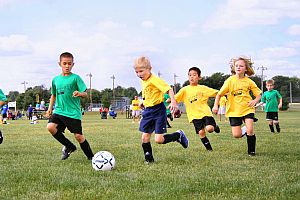Overuse Injuries in Young Athletes: An Introduction for Parents

There’s a curious dynamic at work in youth sports these days. Maybe you’ve noticed?
On the one hand, public health officials are worried about a broad decline in team sport participation among children. According to a recent survey, the number of kids between the ages of 6 and 17 who play organized baseball, basketball, football, and soccer fell about 4% between 2008 and 2012.
And on the other hand, healthcare professionals are also worried about many of the estimated 60 million children in the U.S. who do play organized team sports. They see signs that young athletes may be taking their sports too seriously—training too hard, playing too much and specializing too early in life. The popular media offers many statistics and anecdotes that seem to point in this direction:
- “While injuries from recreational activities such as biking have fallen over the last decade, team sports including football and soccer saw injuries rise by 22.8% and 10.8% respectively…” (Wall Street Journal)
- “While concussions account for about 15% of youth sports injuries, experts say many sports carry risks for musculoskeletal injuries, in large part due to increased emphasis on year-round competition, single-sport concentration and intense training regimens, even for pre-teen athletes.” (Wall Street Journal)
- “Overuse and overtraining are also major concerns… As children become good at competitive sports, there is sometimes an impulse to keep them in the same sport year round, which may not be the healthiest thing for a young athlete.” (HealthDay News)
What’s more alarming to physicians than the number of youth sports injuries is the nature of those injuries. A troubling new pattern seems to be emerging. According to Dr. Amy Valasek, a sports medicine expert at Johns Hopkins Children’s Center, only about half the sports injuries she sees are the sorts of sprains, strains, fractures and concussions that have traditionally been common among young athletes. 50% to 60% of them are related to overuse. Because the musculoskeletal system of children and teenagers is still growing, they may be especially susceptible to these kinds of injuries.
Unsurprisingly, each sport has its own risk profile when it comes to overuse injuries. For instance, overuse injuries of the shin and knees are most common to runners. Baseball, softball and football players often have elbow and shoulder injuries. Cheerleaders, skaters and dancers are prone to ankle injuries. And gymnasts frequently encounter wrist injuries as a result of the extreme demands their sport places on this particular part of the body.
In addition, doctors say they tend to these types of overuse injuries more often in children who play one sport year-round or play over multiple consecutive seasons without taking a break rather than in those who participate in a variety of athletic activities. Recent research found serious overuse injuries are 2.3 times more common in young, single-sport athletes than they are in more well-rounded athletes, even after accounting for the number of hours committed.
There may be several reasons for the apparent trend in overuse injuries. Experts believe that there’s growing pressure among athletes to specialize in one sport—and sometimes even in one position—at a younger and younger age. They also believe that youth training programs and competition schedules are simply becoming more demanding. At the same time, though, it’s likely that many managers and coaches at this level (not to mention parents) don’t fully understand the risks and don’t work with their young athletes to build healthy training and injury prevention habits. And when they are injured, it’s not uncommon for children to return to practice before their injuries are completely healed.
So what’s the best advice for the parents of a talented (or even just enthusiastic) young athlete?
- Encourage a wide variety of athletic activities and well-rounded development. Evidence suggests that playing more sports leads to fewer overuse injuries, lower burnout rates and better overall performance in the long run. While there’s no hard-and-fast “rule,” many experts suggest that children and parents avoid specializing in a single sport before the age of 14.
- Take time off. The American Academy of Pediatrics Council on Sports Medicine and Fitness advises that children practice no more than five days per week and take at least one day off from any organized training. Some experts offer an alternative rule-of-thumb: young athletes shouldn’t participate in a sports more hours a week than their age. The Council also suggests a 2- to 3-month break to recover between seasons.
- Teach—and practice—injury prevention from an early age. Warm-ups and whole-body stretches should become lifelong habits.
- Be sure your athlete understands what overuse injuries are, how to recognize them and how they should be treated.
Additional Resources
Intense, Specialized Training in Young Athletes Linked to Serious Overuse Injuries. http://www.newswise.com/articles/intense-specialized-training-in-young-athletes-linked-to-serious-overuse-injuries
Sports Should Be Child’s Play. http://www.nytimes.com/2014/06/11/opinion/sports-should-be-childs-play.html
Guidelines for Young Athletes to Reduce Injuries. http://online.wsj.com/articles/guidelines-for-young-athletes-to-reduce-injuries-1416869652
One thought on “Overuse Injuries in Young Athletes: An Introduction for Parents”
Very well-written and interesting post. Thanks for sharing. I find 4% quite large in the grand scheme of things but then it makes me wonder if this number fluctuates often or what. I know it’s a percentage over a 4 year period though, so I guess it’s technically reflecting a down trend.
Comments are closed.